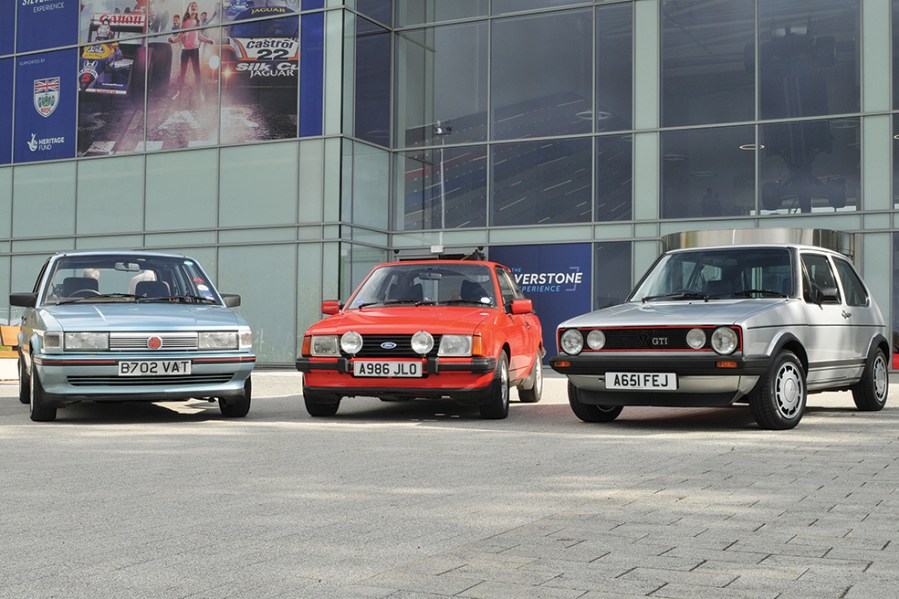We pit the original Golf GTI against its MG Maestro and Escort XR3i rivals from the glory days of hot hatchbacks
Words and images: Paul Wager, Joe Miller
We may have first seen the GTI badge in the mid 1970s, but it’s generally associated with the decade of Tony Hadley and Simon Le Bon, and specifically with either the VW Golf or the Peugeot 205.
Ironically, the go-faster Golf very nearly didn’t make it to production reality but its success ensured that it would continue into the 21st century, now in its eighth generation.
It also ensured that every major European marque had its own take on the recipe, which was in truth pretty simple: take your mainstream front-drive hatchback in its largest-engined form and spice it up with a few extra horsepower to lift the performance above the regular offering. Add some red piping and send it to market.
In most cases that spicing up was achieved via fuel injection, in most cases courtesy of Bosch, whose analogue K-Jetronic system was pretty much standard fit on any performance car back then and gave a useful marketing boost with that coveted ‘i’ giving a high-tech image.
When it comes to the pecking order, the Golf was the original and the Escort XR3i was the sales volume champion, but both were offered in two-door form only. If you wanted the practicality of four doors then you were out of luck… which is where the revamped MG marque came in. The MG Maestro may have got off to an awkward start before finding its feet in later 2.0i form when it challenged the Mk2 Golf, but it was of course built only in four-door form.
There were many early-1980s buyers for whom that was enough to tip the balance, but how does the MG shape up against the XR3i and GTI today?
Ford Escort XR3i
Launched in September 1980, the Mk3 Escort had notched up production of 823,000 by 1982, but what the range did lack was a serious performance model to tempt buyers trading in their Mk2 RS2000s. Yes, there was the XR3 but the Weber-carburetted 1600 CVH could only muster 96bhp, which made it slower to 60mph than the older RS.
Clearly Ford didn’t want to lose buyers to the Astra GTE or Golf GTI and so a go-faster model was conceived which first appeared in 1981 as the RS1600i. Based on the XR3, it was something of a homologation special designed to allow Ford to compete in Group A motorsport rather than set the showrooms alight. But the appeal of a 115bhp high-compression engine boasting solid lifters, uprated camshaft, electronic ignition and Bosch injection ensured it was a hit with the RS faithful, especially when paired with strobe-effect graphics, alloy wheels, sports seats and uprated suspension.
Out of the 8659 made, 2600 were sold in the UK and with the potential for an Escort-based GTI challenger evident, legend has it that Ford Motorsport despatched an early RS1600i from Cologne to Dunton and told the SVE engineers they were welcome to copy it to make a fuel-injected XR3i, whereupon a case of ‘not invented here’ meant it was parked up in a corner and duly ignored.
Whether that’s true or not , it’s a great tale and reflects the fact that little of the engineering from the specialist RS1600i went into the mainstream XR3i, a car which was reputedly the work of a team of just ten people.
Key to the brief was the requirement for fuel injection – while retaining the standard 9.5:1 compression – as well as improvements to the suspension on rough surfaces and in everyday ownership.
It was the fuel injection which required the biggest changes, since it involved reworking the fuel system to provide a high pressure supply and return lines to the tank, as well as modified inlet and exhaust manifolding.
On the suspension front, revised top mounts would have reportedly cost $1.5m, which meant SVE was forced to explore other options to reduce the positive front-end camber, eventually settling for revised lower strut-to-hub mountings instead. The dampers were swapped for Girling gas units and new springs lowered the ride height by 30mm front and 20mm rear, the front springs shared with the XR3 and the rear springs actually softened slightly over the dual-rate XR3 items. The brakes were deemed to be better than the RS1600i, using a right-hand drive servo rather than the RS’s cross-linkage which kept the servo on the left, while the rear gained the bigger drums from the Escort van.
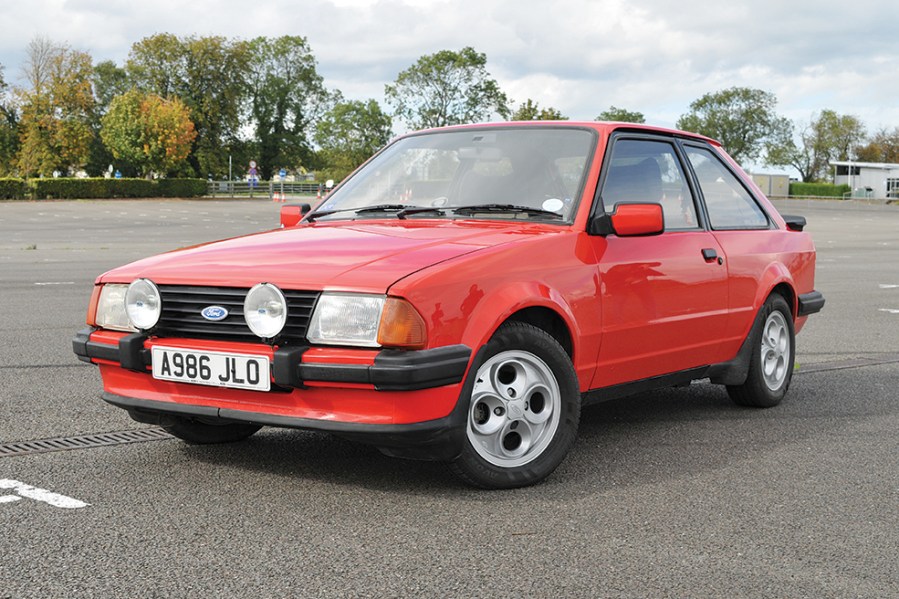
The XR3i would later gain Ford’s own EEC-IV injection and engine management for the facelifted ‘Mk4’ model but the car we have here is the XR3i in its pure early form. The striking Sunburst Red paint combines nicely with the black plastic spoilers to create an overall effect which is pure ’80s and all the better for it, especially on the signature ‘cloverleaf’ 14-inch alloys.
You don’t see too many XR3i’s in this kind of condition and for good reason: they’re a tricky car to restore thanks to Ford’s lack of any kind of heritage operation for its European cars. Yes, the usual Ford specialists can keep you supplied with mechanical parts, but when it comes to trim and detail parts to finish off a restoration, used parts are your only bet. In fact, we had to resort to a 3D printing fittings for the parcel shelf on this car, while the dashboard moulding has simply drooped with age and replacements simply aren’t available.
Those are perhaps minor details though: what’s it like to drive? Like many readers, I had extensive experience of the Mk3 Escort back in the day and just sitting in the XR3i brings back some memories… some good, some bad and rather too many perhaps best left buried.
The first impression is that unsurprisingly, it lacks the quality feel of the Golf, the heft of the door and the precision of the switchgear being more akin to the Maestro. Twist the key though and it’s all very familiar as the injection means the CVH invariably bursts into life immediately.
The shift action is a little rubbery but precise enough and the light pedal action reminds you that this was a car aimed very much at the mainstream – buyers who were trading up from a 1.3L, rather than old-school metal like MGB or TR6.
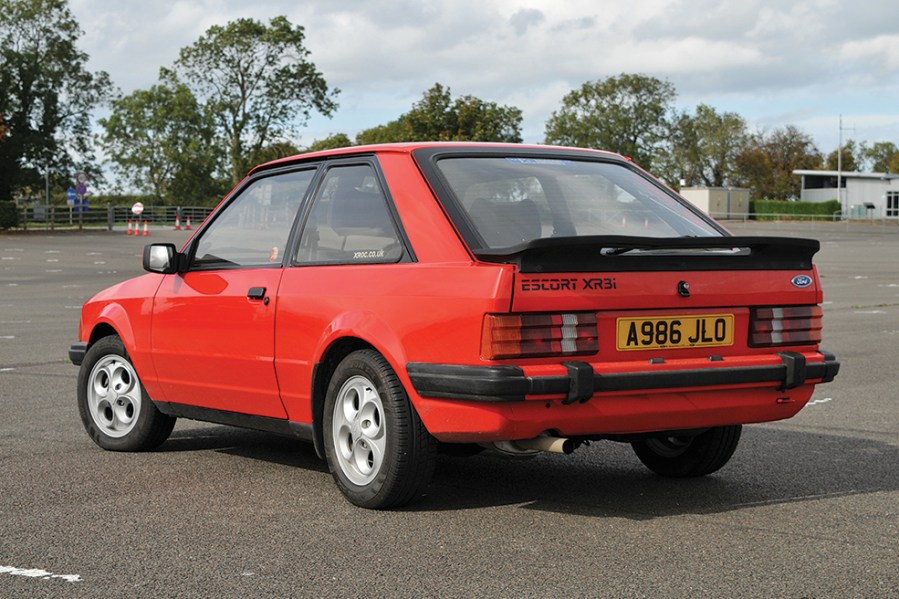
The analogue K-Jetronic injection is often criticised for its basic design but it does generally make for a crisp throttle response – sharper in fact than some early electronic injection systems – and in a straight line the Escort still feels brisk. It may only have 105bhp on tap, but the lack of safety kit means cars were light back then and it tips the scales at just 950kg.
As well as airbags and ABS, hot hatches of this period naturally also lacked any kind of traction control and this means that while the Escort grips well in the dry, it can be a touch unruly on wet roads – nothing like the more powerful RS Turbo, but certainly it will scrabble the front end from a standing start.
It’s when you drive it hard that the XR3i starts to come up against its own limits pretty quickly, which isn’t so much a criticism but a reflection of how perfectly Ford judged the car for its intended market. The majority of Escort buyers simply wanted a car which was quicker than the cooking models and looked the part but weren’t into the nuances of its on-limit handling.
Which is just as well, since the car becomes a bit unruly when asked to really push on. It may have an independent rear end but it feels somewhat wooden, not helped by slow steering and brakes which really don’t inspire confidence.
At speed, it’s also noisy even by the standards of the time, not helped by the standard tilt-n-slide sunroof which was always a tricky thing to get adjusted just-so. On the other hand, nobody ever bought an XR3i for Lexus levels of refinement, and you can’t deny that a Sunburst Red XR3i is a great fun way to enjoy some nostalgia. Is that enough to unseat the original though?

VW Golf GTI Mk1
Like other iconic classics from Minor to E-type, the original Golf GTI’s life story has been explained many times in these pages before, but the car very nearly failed to make it to production: engineers had created a so-called Sport Golf after hours using a discarded Scirocco prototype producing 100bhp from a twin-choke carb on the standard 1600 motor.
A conservative management had initially been unwilling to sanction a sporting model but happily it coincided with the need for a crowd-pleaser at that year’s Frankfurt Show and the go-ahead was given in 1975. The show concept used the 1.6-litre injected engine borrowed from the Audi 80 GTE and it was VW designer Herbert Schaeffer (later of Corrado fame) who added the final touches which would be enduring GTI signatures: the red pinstriped grille, chin spoiler, golf ball gearknob, black rear window surround and the checked seats.
The reaction was overwhelmingly positive, encouraging VW to build a pilot run of 5000 cars which soon became a permanent model. The GTI was launched in mid-’76, arriving in special order left-hand drive form here in October before we received right-hand drive cars from July 1979.
In January 1980 the GTI received a five-speed gearbox and in August of that year a light facelift included larger rear lights and updated dashboard, instruments and switchgear. In August 1982 the engine was revised to 1781cc with an increased bore and stroke necessitating a new crankshaft while valve size was increased and the head was revised to run a 10:1 compression ratio. Maximum power was increased only slightly but torque was usefully increased from 103lb.ft at 5000rpm to 109lb.ft at 3500rpm.
Production would end in the summer of 1983, with new cars registered into 1984 and it’s one of the later examples we have here. Wearing the A plate, it was registered in January 1984 and it betters even the XR3i in its immaculate presentation. As indeed you would expect, since this is Volkswagen UK’s own car and with 45,000 miles showing is as close to a brand new Mk1 as you’ll get, right down to the OE-option Blaupunkt Cambridge cassette deck.

Naturally the VW was more expensive than the Ford back in the day but not by as much as you’d think: in 1983, the GTI was £6808 while the XR3i was £6151 but the quality of construction is in a different league. Beetle owners used to boast that their cars were so well sealed that slamming the door required the window cracking open a touch first to relieve the air pressure and the same is true of the Golf. Once inside, the solidity of the cabin fittings is noticeable against the Ford – the VW dashboard and door cards still look like they did when the car left Wolfsburg’s Hall 54, unlike the droopy Ford fascia and flimsy door cards.
You sit higher in the Golf, an impression reinforced by its firmer seats and the high-set instrument cluster and with all the black plastic it’s a darker environment than the Ford – typical ’80s German.
Like the Escort, the injected VW engine starts and idles without drama and like the XR3i, the GTI is as easy to drive as the most basic 1-litre model. Despite its long (by today’s standards) travel, the gearshift feels noticeably more positive than the rubbery Escort lever and at slower speeds the higher-geared steering also requires more heft.
As you’d expect, the Golf’s 200cc advantage over the Escort gives it the edge but the extra shove is most noticeable not in a full-bore straight-line sprint but in the mid range where the Golf just feels that bit more muscular, with less stirring of the gearbox. It all adds up to car which is simply easier to drive in everyday conditions and as a result feels more sophisticated as a result.
Ask it to perform though, and it’s got the fizz for which these ’80s hatches were remembered. The VW engine may not be a high-rev screamer number in the Honda mould but it’s definitely more eager than the grumbly CVH and for an eight-valver is lively enough.
Back in the day, road testers trying these cars at the extreme on track felt that the Escort was generally more predictable at the limit than the Golf, the trade-off being that the Golf is the more responsive of the two and ultimately the more capable. In theory the Golf’s simple beam rear axle should see it lose out to the Escort with its more sophisticated independent rear but that’s not the case; in fact in spirited road driving the Golf feels the more agile of the two, mainly because its quicker steering offers that much more feel.
It doesn’t win on all counts though. VW retained a left-hand drive master cylinder with a cross-linkage to the right-hand drive pedal box and the brakes of the Mk1 have always been criticised for their wooden feel. Aftermarket pads improve things to some extent and they’re always up to stopping the car, but they just lack any kind of confidence-inspiring feel.
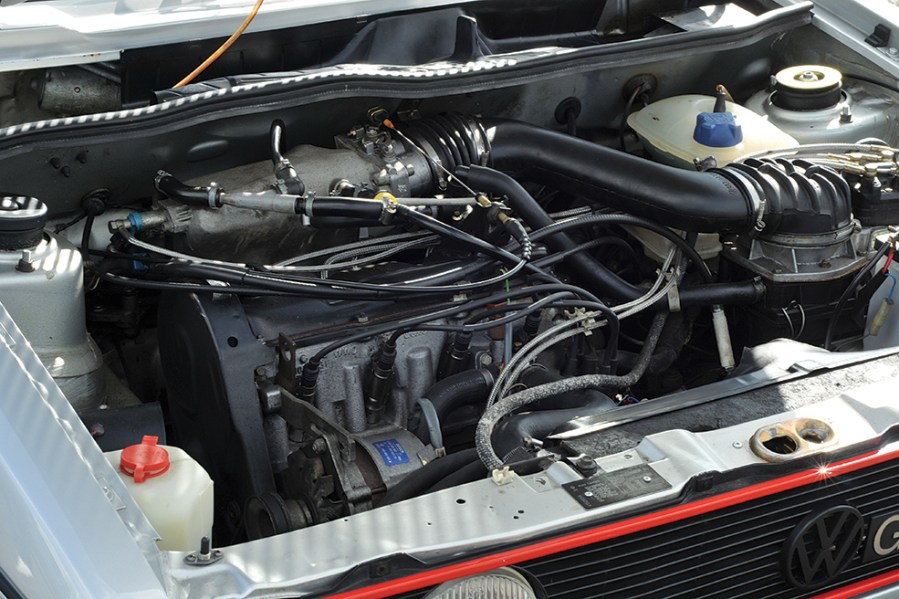
MG Maestro 1.6i
And so we come to the wildcard in this test: the British contender in the shape of the MG Maestro 1600, created by fitting twin Webers to the 1.6-litre R-Series engine, itself developed by modifying the E-Series engine to take a conventional end-on gearbox.
The styling of the Maestro and Montego was mired in controversy but time has been kind to them, especially the MG incarnations which thanks to chunky alloys and colour-coded plastic bumpers lost the dumpy look of basic models.
The Austin Rover stylists took Schaeffer’s red pinstripe and ran riot with it, the MG models of this era famously receiving red seatbelts as well as red carpets and of course that famous octagonal badge on the grille. There was also a tremendous talking point in the shape of the on-board voice synthesizer which would speak the warnings to you… rather more frequently than many owners had expected.
The MG Maestro would later gain the updated S-Series engine which would itself be replaced by the 2-litre O-Series unit from 1985, in which guise the MG actually had the audacity to challenge the Mk2 Golf GTI for straight-line speed.
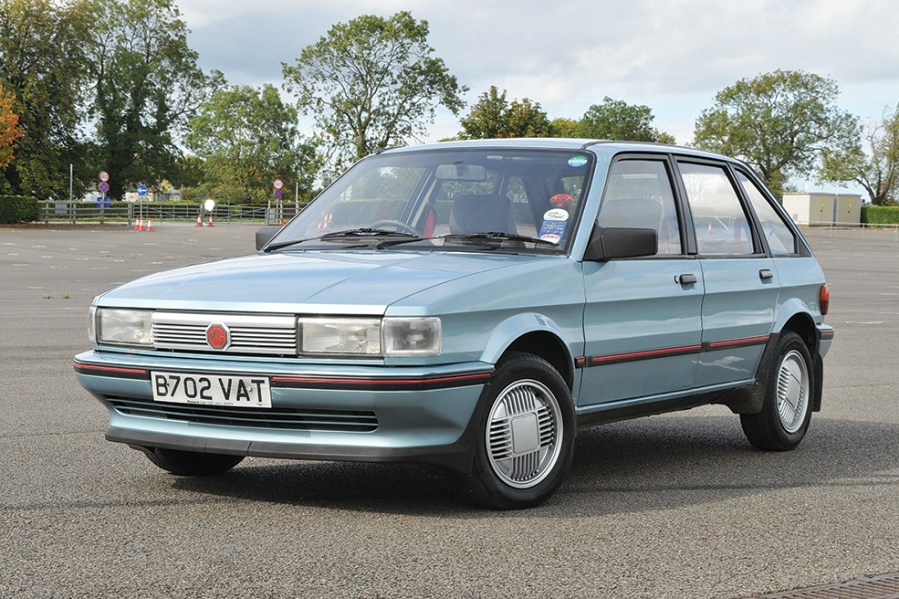
It’s the rare S-Series car we have here though, which is at once both a rarity and an intriguing beast, the more so when compared with the other cars here. Nobody would expect mid-’80s Austin Rover quality to be up to Wolfsburg but the first surprise is that the Maestro feels in some ways like a less cheaply-made car than the Escort. At £6465 in 1983, it was just £314 more than the Ford, while offering an extra pair of doors which meant that in many ways it was a far better value proposition.
The other, rather bigger, surprise that the MG Maestro isn’t half bad to drive. There, I said it… but I’ll stand by it. My main memory of the Maestro comes from shabby basic models run on student budgets and in comparison to the 1.3 A-Series models, the plushly trimmed MG model feels both vastly more pleasant and also a lot more lively. The Webers provide a crisper response than the two injected cars and even though it boasts just 103bhp, it feels lively enough to be fun even if the XR3i and GTI would leave it for dead in a straight line.
The carbs did come with a downside though: both S and R-Series were known for suffering fuel vaporisation issues when new, caused mainly by its non-crossflow design which sites the carburettors right above the hot exhaust manifold. The result is that our photo shoot was punctuated by periods of cranking when someone inadvertently switched off the key with a warm engine. We suspect a missing heat shield was the culprit but it does highlight the difference in development budgets between Ford, VW and MG.
On the road, the Maestro falls somewhere between the Escort and the Golf. It’s softer-sprung than the other pair but still manages decent body control and as for the controls… well if the gearshift feels curiously similar to the Golf, that’s because it’s a VW gearbox, the cost accountants having discovered that it was cheaper to buy the units wholesale from Germany than to develop a suitable box in house.

It also feels more lively than the figures suggest: Autocar managed to scrabble to 60mph in 9.6 seconds and max out their Maestro at 112mph, which puts it behind the Golf and Escort but not by the huge margin you might expect.
Handling too is similar to the Golf, although less lively thanks to the softer suspension and lower-geared steering, with the car tending towards safe understeer and generally feeling benign in its behaviour; certainly MG didn’t give its buyers the unsettling moments Peugeot provided for its GTI customers.
All in all, the Maestro had all of us on CCM pleasantly surprised at its capability, which some staffers reckoned made it the better car than the Escort which beat it so comprehensively in the sales charts. And we know from experience that the S-Series and then the 2-litre O-Series Maestros were even better. Once again, an incredible result from a budget-starved BL development team.

Our verdict
All three of these cars explain just why the hot hatch became so popular – and all three offer performance which even by today’s standards is sufficient to be fun. It’s easy to see why the Golf was so popular back in the day and its blend of quality build and driver appeal still wins the day here. It’s also the easiest car to own thanks to specialist parts support and even the efforts of VW’s own Classic operation. Everyone loves the Escort for its ’80s style but invariably they’re disappointed by the driving experience, while the part supply issues mean that today it’s really one for the committed Ford enthusiast.
On which subject the Maestro is even more of a niche choice and certainly not something you’d own by accident. If anything it’s even more of a talking point than the Escort and the next time you see a well-preserved MG Maestro on the road you can mentally give the owner credit for the lengths they’ve gone to in order to keep it up together.
All of the above means the winner is once again the Golf, with the Maestro in a surprising second place and the Escort trailing in third.

